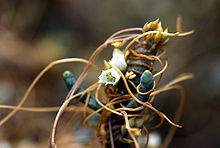- Cuscuta salina
-
Cuscuta salina 
Scientific classification Kingdom: Plantae (unranked): Angiosperms (unranked): Eudicots (unranked): Asterids Order: Solanales Family: Convolvulaceae Genus: Cuscuta Species: C. salina Binomial name Cuscuta salina
Engelm.Cuscuta salina is a species of dodder known by the common name salt marsh dodder. It is native to western North America, where it lives in seasonal alkaline or saline habitats such as vernal pools and salt flats. It is a parasitic plant, wrapping itself around wetland vegetation and tapping them for nutrients with its haustoria. This is a slender annual vine extending yellowish thready stems to wrap tightly around other plants. The leaves are rudimentary and scale-like. The dodder produces flowers with white glandular corollas. Each is bell-shaped with five pointed triangular lobes.
Previous treatments of the species divided it into three varieties. In 2009, two of them were combined into a separate species called Cuscuta pacifica.[1] The two species can easily be differentiated by habitat geography: the varieties of Cuscuta pacifica grow solely in coastal habitats while Cuscuta salina sensu stricto grows inland in alkaline or saline seasonally wet habitats such as vernal pools and salt flats, such as the margins of the Great Salt Lake.
References
- ^ Costea, M., et al. (2009). Untangling the systematics of salt marsh dodders: Cuscuta pacifica, a new segregate species from Cuscuta salina (Convolvulaceae). Systematic Botany 34(4) 787-795.
External links

This Solanales article is a stub. You can help Wikipedia by expanding it.
